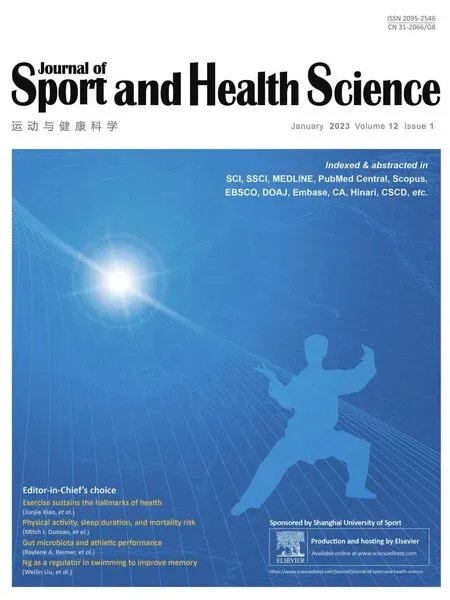The role of neurogranin in exercise-induced adaptation to brain
2023-04-15ZsoltRadak
Zsolt Rad-ak
Research Center of Molecular Exercise Science,University of Physical Education,Budapest 1123,Hungary
The screening of the rat brain complementary DNA library revealed a novel,previously unidentified,protein with 78 amino acids,which is now called neurogranin(Ng).1The human brain also contains Ng,and it is 96% identical with rodent Ng.Besides being a neuronal postsynaptic protein,Ng has been found in lung,bone marrow,and epithelial cells.Ablation of Ng in mice resulted in an impairment of spatial learning and changes in hippocampal short-and long-term plasticity.2Based on this observation,it is not surprising that we see Ng levels decline with aging and that the suppressed level of Ng is associated with neurodegenerative and mental diseases including Alzheimer’s disease,Parkinson disease,and schizophrenia.3
The beneficial,health promoting effects of exercise on human and rodent brains is well documented and takes place via complex cellular signaling pathways.4-8
A recent study by Di Battista et al.9on human subjects reported that short term(2 weeks)high-intensity interval cycling training(8-12£60-s intervals at 100% of peak power output on a cycle ergometer,interspersed by 75-s recovery at 50%max)resulted in an increased concentration of brain-derived proteins in the plasma of subjects,including Ng.However,the physiological consequences,if any,remain to be elucidated.
Lin and co-workers10showed again the deleterious effects of Ng ablation or bilateral common carotid artery stenosis on spatial memory,which was significantly attenuated by regular swimming exercise.Moreover,the findings of this study revealed that swim training rescues calmodulin and calcium/calmodulin-dependent protein kinase II(CaMKII),both of which affect Ca2+transduction and were suppressed by Ng ablation or bilateral common carotid artery stenosis.It has also been demonstrated that swim training modulates inflammation and injury in the white matter caused by knocking out Ng or by bilateral common carotid artery stenosis.Therefore,the present paper by Lin and co-workers10highlights a new neuroprotective agent by which exercise contributes to brain health,function,and treatment of some neurodegenerative diseases.
It appears that the puzzle of how exercise benefits brain function is further elucidated by these findings,which suggest that there are a number of new proteins and pathways by which exercise may benefit memory,learning,synaptic plasticity,and resistance to neuro injury,or support regeneration following brain trauma.
Competing interests
The author declares that he has no competing interests.
杂志排行
Journal of Sport and Health Science的其它文章
- Erratum to Can physical activity eliminate the mortality risk associated with poor sleep?A 15-year follow-up of 341,248 MJ Cohort participants[J Sport Health Sci 11(2022)596-604]
- A lateral ankle sprain during a lateral backward step in badminton:A case report of a televised injury incident
- Creating Prep to Play PRO for women playing elite Australian football:A how-to guide for developing injury-prevention programs
- Neurogranin as an important regulator in swimming training to improve the spatial memory dysfunction of mice with chronic cerebral hypoperfusion
- The moderating effect of physical activity on the relationship between bullying and mental health among sexual and gender minority youth
- The impact of height-adjustable desks and classroom prompts on classroom sitting time,social,and motivational factors among adolescents
